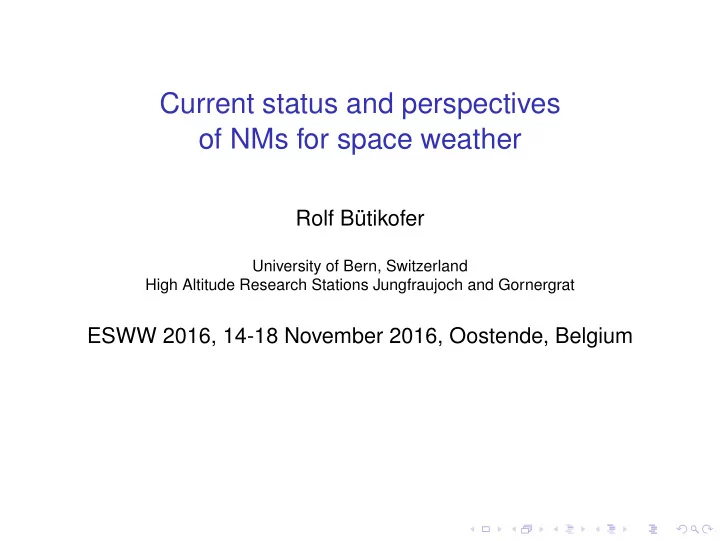

Current status and perspectives of NMs for space weather Rolf B¨ utikofer University of Bern, Switzerland High Altitude Research Stations Jungfraujoch and Gornergrat ESWW 2016, 14-18 November 2016, Oostende, Belgium
Neutron monitors (NMs) I • Worldwide network of standardized NMs since late 1950s → long-time registration, constant location (homogenous data) • Examine temporal and spatial variations of Cosmic Rays (CRs) in space environment • Ensemble of NMs together with geomagnetic field acts as a giant spectrometer in energy range ∼ 500 MeV to ∼ 15 GeV • Extension to low-energy ranges measured on spacecrafts
Neutron monitors (NMs) II • Standardized detector types (IGY and NM64) • About 50 NM stations in operation • Many NM stations send data to NMDB, ∼ 30 in real-time www.nmdb.eu
What information do we get from NMs • Time variations of CR intensity Time resolution of NMs: 1 minute → CR phenomena with times over 1 minute can be investigated (statistics) • NMs at different geomagnetic latitudes → different cutoff rigidities → From GLE data base http://gle.oulu.fi/ information about the spectrum of CRs near Earth in energy range ∼ 500 MeV - 15 GeV • NM stations “looking in different directions” → information about anisotropy of CR From NMDB http://www.nmdb.eu
What information do we get from NMs • Time variations of CR intensity Time resolution of NMs: 1 minute → CR phenomena with times over 1 minute can be investigated (statistics) • NMs at different geomagnetic latitudes → different cutoff rigidities → information about the spectrum of CRs near Earth in energy range ∼ 500 MeV - 15 GeV • NM stations “looking in different directions” → information about anisotropy
What information do we get from NMs • Time variations of CR intensity Time resolution of NMs: 1 minute → CR phenomena with times over 1 minute can be investigated (statistics) • NMs at different geomagnetic latitudes → different cutoff rigidities → information about the spectrum of CRs near Earth in energy range ∼ 500 MeV - 15 GeV • NM stations “looking in different directions” → information about anisotropy of CR
Space Weather phenomena and NMs • Most energetic solar energetic particle (SEP) events → observed by NMs (Ground Level Enhancement – GLE) → forecast of large solar CR intensity / assessment of SEP characteristics • Approaching ICMEs and their accompanying shocks → loss cone precursors, i.e. suppression of CR intensity for particles arriving from the sunward magnetic field directions → forecast of geomagnetic storm • Sudden storm commencements → change of cutoff rigidity → change in NM count rates → nowcast of geomagnetic storm
GLE alarm systems I Athens Real Time GLE ALERT GLE alarm from Bartol Neutron System Monitors www.bartol.udel.edu/ takao/neutronm/glealarm/index.html http://swe.ssa.esa.int/space-radiation
GLE alarm systems II GLE alert ∼ 10 – ∼ 30 minutes before earliest proton alert by Space Environment Center (Kuwabara et al., 2006)
NMDB: Real-time GLE calculations I
NMDB: Real-time GLE calculations II
AVIDOS 2.0 Informational and educational online software for the assessment of radiation dose exposure at flight altitudes during quiet and extraordinary solar conditions caused by CRs. http://swe.ssa.esa.int/nso air
Space Weather phenomena and NMs • Most energetic solar energetic particle (SEP) events → observed by NMs (Ground Level Enhancement – GLE) → forecast of large solar CR intensity / assessment of SEP characteristics • Approaching ICMEs and their accompanying shocks → loss cone precursors, i.e. suppression of CR intensity for particles arriving from the sunward magnetic field directions → forecast of geomagnetic storm • Sudden storm commencements → change of cutoff rigidity → change in NM count rates → nowcast of geomagnetic storm
Loss cone • Circle is plotted at time of observation (abscissa) and pitch angle of asymptotic viewing direction (ordinate) • Red circle indicates a deficit intensity relative to omni- directional average, and blue circle indicates excess intensity; scale is indicated at the right of plot • Arrival of ICME is evidenced by large red circles concentrated near 0 ◦ pitch angle http://neutronm.bartol.udel.edu/spaceweather/welcome.html
Space Weather phenomena and NMs • Most energetic solar energetic particle (SEP) events → observed by NMs (Ground Level Enhancement – GLE) → forecast of large solar CR intensity / assessment of SEP characteristics • Approaching ICMEs and their accompanying shocks → loss cone precursors, i.e. suppression of CR intensity for particles arriving from the sunward magnetic field directions → forecast of geomagnetic storm • Sudden storm commencements → change of cutoff rigidity → change in NM count rates → nowcast of geomagnetic storm
Change in cutoff rigidity Relative count rates of the NM stations Kp-index for 9-11 November 2016 Oulu ( R c = 0 . 8GV), Lomnicky Stit ( R c = 3 . 8GV), Jungfraujoch ( R c = 4 . 5GV), and Rome ( R c = 6 . 3GV)
Space Weather Portals with use of NM data • Bartol group, http://neutronm.bartol.udel.edu/ • Athens Neutron Monitor Station (A.NE.MO.S), http://cosray.phys.uoa.gr/ • IZMIRAN, Moscow, http://cosrays.izmiran.ru/ • Aragats Space Environmental Center (ASEC) / Space Environmental Viewing and Analysis Network (SEVAN), http://crd.yerphi.am/ • ReSoLVE (Research on SOlar Long-term Variability and Effects), http://www.spaceclimate.fi/resolve/index.html
Perspective of NMs for space weather • Data of as much NM stations as possible available in real-time • Improvement of GLE analysis (yield function, transport in Earth’s magnetic field, ...) • Operate small NM devices (mobile NMs) at high altitudes • Virtual observatory (VO): combine NM Space Weather applications on one portal • Terrestrial gamma-ray flash (TGF) / Thunderstorm Ground Enhancement (TGE) and NM measurements
Recommend
More recommend